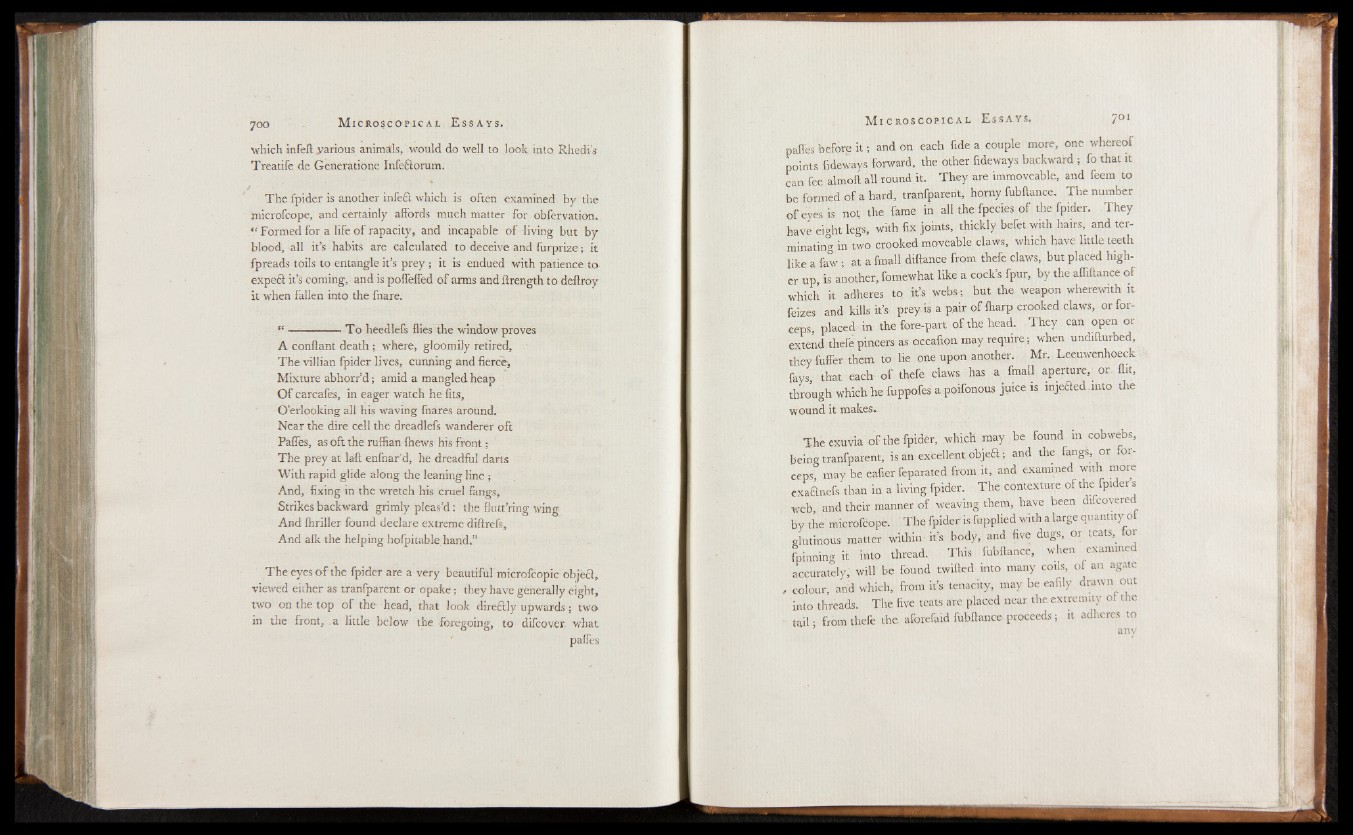
which infeft yarious animals, would do well to look into Rhedi’s
Treadle de Generatione Infeftorum.
The fpider is another infeft which is often examined by the
microfcope, and certainly affords much matter for obfervation.
“ Formed for a life o f rapacity, and incapable o f living but by
blood, all it’s habits are calculated to deceive and furprize; it
fpreads toils to entangle it’s prey ; it is endued with patience to
expeft it’s coming, and is poffeffed o f arms and ftrength to deftroy
it when fallen into the fnare.
“ ........ T o heedlefs flies the window proves
A conftant death ; where, gloomily retired,
The villian fpider lives, cunning and fierce,
Mixture abhorr’d ; amid a mangled heap
O f carcafes, in eager watch he fits,
O ’erlooking all his waving fiiares around.
Near the dire cell the dreadlefs wanderer oft
Pafles, as oft the ruffian fhews his front;
The prey at laft enfnar’d, he dreadful darts
With rapid glide along the leaning line ;
And, fixing in the wretch his cruel fangs,
Strikes backward grimly pleas’d : the flutt’ring wing
And fhriller found declare extreme diftrefs,
And alk the helping hofpitable hand.”
The eyes o f the fpider are a very beautiful microfcopic objeft,
viewed either as tranfparent or opake; they have generally eight,
two on the top of the head, that look direftly upwards; two
in the front, a little below the foregoing, to difcover what
paffes
paffes before i t ; and on each fide a couple more, one whereof
points fideways forward, the other Tideways backward ; fo that it
can fee almoft all round.it. They are immoveable, and feem to
be formed of a hard, tranfparent, homy fubftance. The number
o f eyes is not the fame in all the fpecies of the fpider. They
have eight legs, with fix joints, thickly befetwith hairs, and terminating
in two crooked moveable claws, which have little teeth
like a faw ; at a fmall diftance from thefe claws, but placed higher
up, is another, fomewhat like a cock’s fpur, by the afliftance of
which it adheres to it’s webs ; but the weapon wherewith it
feizes and kills it’s prey is a pair o f (harp crooked claws, or forceps,
placed in the fore-part of the head. They can open or
extend thefe pincers as occafion may require; when undifturbed,
they fuffer them to lie one upon another. Mr. Leeuwenhoeck
fays that each o f thefe claws has a fmall aperture, or flit,
through which he fuppofes a poifonous juice is injefted.mto the
wound it makes-.
The e-xuvia o f the fpider, which may be found in cobwebs,
being tranfparent, is an excellent objeft; and the fangs, or forceps
may be eafier feparated from it, and examined with more
exaftnefs than in a living fpider. The contexture of the fpider’s
web, and their manner of weaving them, have been difcovered
by the microfcope. The fpider is fupplied with a large quantity o
glutinous matter within it’s body, and five dugs, or teats,^ for
{binning it into thread. This fubftance, when examined
accurately, will be found twifted into many coils, of an agate
, colour, and which, from it’s tenacity, may be eafily drawn out
into threads. The five teats are placed near the extremity of the
tail • from thefe the aforefaid fubftance proceeds; it adheres to
1 any